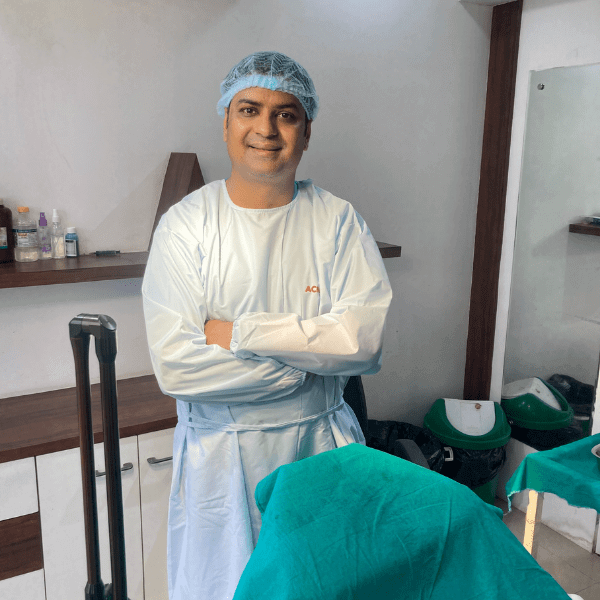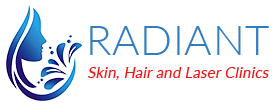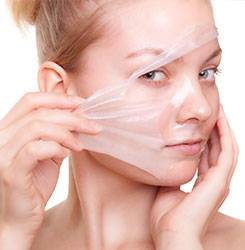Indian skin faces a lot of tantrums which can take us to dermatologists. From psoriasis to freckles, our skin faces a lot of obstacles. The environmental conditions, allergens, food allergies et cetera affect our skin immensely.
To deal with these issues, Dr. Abhishek Malviya is always ready to help round the clock. His 10+ years of experience and expertise as a dermatologist have cured a lot of patients. He has a 100% success rate in his experience. He is one of the best dermatologists in Indore. His personalized treatment has won the hearts of many clients.
Reasons Why Dr. Abhishek Malviya is the Best Dermatologist in Indore

Dr. Abhishek Malviya is an Indore dermatologist, surgeon, and skin expert. His talent has been impressive since the onset of his career. He has always gone out of his way to help others, no matter their age. Dr. Abhishek Malviya is the top skin expert in Indore for the following reasons:
- He has been one of the most successful dermatologists and surgeons.
- He offers advanced dermatology treatment in Indore.
- He provides numerous sittings before proceeding with treatment.
- He has experience of above 10 years without a failed treatment
- He helps in boosting confidence in patients who are demoralized due to their falling dermatological health.
- His history of treating patients has an exponential career graph.
- He studies your health history thoroughly to come up with a treatment course, i.e., his treatment course is personalized for every patient.
- He has the best facilities for cosmetic surgeries and solutions for reshaping facial organs, extra fats in the body, et cetera.
Why Choose Radiant Skin Clinic if you are Looking for a Hair Specialist in Indore?
Radiant Skin Clinic, run by Dr. Abhishek Malviya, has been recognized as one of the best dermatological clinics in Indore. Radiant Skin Clinics provides its patients with high-quality care and a 100% recovery rate.
The following services are offered by Radiant Skin Clinic:
- Best Acne Scar Treatment
- Best Hair Transplant Service
- Expert Skin Consultation and Treatment
- Expert Diseases Consultation and Treatment
- Best Chemical Peeling Service
- Skin Tightening and Anti-Ageing Treatment
- Thread Lift and Dermal Fillers
- Dermaroller/Dermapen
- PRP Therapy Best
- Laser Treatment
- Ear Lobe Repair and
- Ear Piercing
Where can you Find Dr. Malviya’s Dermatological Treatment in Indore?
You’ve chosen the best skin specialist in town to help you get rid of your rashes and skin infection. Dr. Malviya’s expertise and experience have resulted in a successful practice in town. He may be found at the following places, in addition to Radiant Skin Clinic:
- Dewas: Kothari medical opposite MG Hospital on Wednesdays.
- Manawar: Kailash hospital Chaitanyadham on every 2nd and 4th Sunday
- Ratlam: Arogyam hospital college road near civil hospital on every 1st and 3rd Saturday.
Book an Appointment
To avoid hospital complications, Dr. Abhishek Malviya’s Radiant Skin Clinic is located on the third floor of the Krishna Tower, ICICI and Baroda Bank Building, Greater Brijeshwari, Opposite IDA Scheme 140, Pipliyahana Indore. You can book a consultation with Dr. Abhishek Malviya by clicking here
Book an Appointment
What is Psoriasis?
Psoriasis is an autoimmune disease that produces an overgrowth of skin cells. Scaling occurs as a result of the accumulation of cells on the skin’s surface.
It’s pretty usual to have inflammation and soreness around the scales. Psoriatic scales are often whitish-silver and appear in dense, red areas. These patches will occasionally shatter and bleed.
Psoriasis is caused by an accelerated skin-production process. Skin cells usually form deep within the skin and then slowly climb to the surface. They eventually fall off. A month is the average life cycle of a skin cell.
This development process can take as little as a few days in persons with psoriasis. Skin cells do not have enough time to fall off as a result of this. Skin cells accumulate as a result of this fast overproduction.
Which Area Does Psoriasis Develop?
Psoriasis develops in:
- Elbows
- Knees
- Hands
- Face
- Neck
- Hands
- Scalp
- Feet
It’s frequently linked to a variety of different disorders, including:
- Type 2 diabetes
- Heart disease
- Anxiety
- Inflammatory bowel disease
- Psoriatic arthritis
Types of Psoriasis
We can find 5 types of psoriasis:
Plaque Psoriasis
It is the most prevalent kind of psoriasis is plaque psoriasis. Plaque psoriasis affects roughly 80% of patients with the disease. It creates red, swollen patches of skin that cover large parts of the body. Scales or plaques of whitish silver often cover these regions. Elbows, knees, and the scalp are frequent sites for these plaques.
Guttate Psoriasis
Guttate psoriasis is a frequent pediatric skin condition. Small pink patches appear as a result of this form of psoriasis. The chest, arms, and legs are the most prevalent areas for guttate psoriasis. Unlike plaque psoriasis, these areas are rarely dense or elevated.
Pustular Psoriasis
Adults are more likely to develop pustular psoriasis. It creates white, pus-filled blisters and red, irritated skin in large regions. Pustular psoriasis usually affects smaller sections of the body, like the hands or feet, although it can also affect other parts of the body.
Inverse Psoriasis
Bright red, glossy, inflamed skin is a symptom of inverse psoriasis. Inverse psoriasis appears as patches under the armpits or breasts, in the groin, or around the genital skin folds.
Erythrodermic Psoriasis
An erythrodermic psoriasis is a severe form of psoriasis that is extremely uncommon. This style frequently covers vast areas of the body at once. The skin seems to be sunburned. Scales that form slough off in big sheets or pieces. A person with this kind of psoriasis is likely to develop a fever or get very unwell. Because this form of infection can be fatal, people should seek medical help very away.
Symptoms of Psoriasis
The symptoms of psoriasis vary from person to person and are determined by the kind of psoriasis. Psoriasis can range in size from a few flakes on the skull or elbow to the entire body.
The following are the most prevalent symptoms of plaque psoriasis:
- Patches of elevated, irritated skin that looks red on fair skin and brown or purple on dark skin.
- Red regions have whitish-silver scales or plaques, whereas purple and brown patches have gray scales.
- Cracked or bloody skin
- Sore patches
- Sensitive and itchy patches
Causes of Psoriasis
Psoriasis is caused by various reasons, including:
- Compromised immune system
- Genetics
What Triggers Psoriasis?
There are a few elements that can trigger psoriasis:
- Stress
- Alcohol
- Injury
- Medications
- Infection
Diagnosing Psoriasis
Depending upon the condition, there can 2 sets of diagnoses:
Physical Examination
A simple physical examination is done to diagnose initially. Psoriasis symptoms are usually obvious and distinguishable from those of other illnesses that might generate similar symptoms.
Biopsy
Skin Sample studies are biopsies. The skin sample is taken from a part of your body part and then is sent to the lab for examining under a microscope. The test can determine which form of psoriasis you have. It can also be used to rule out other illnesses or infections.
Treatment for Psoriasis
There is no cure for psoriasis. The goal of treatment is to minimize inflammation and scales, inhibit skin cell proliferation, and eliminate plaques. There are three types of psoriasis treatments:
Topical Treatment
For mild to moderate psoriasis, creams and ointments applied directly to the skin can assist.
Treatments for psoriasis on the skin include:
- Topical retinoids
- Salicylic acid
- Vitamin D analogs
- Anthralin
- Topical corticosteroids
Systemic Medication
Oral or injectable drugs may be required for those with moderate to severe psoriasis who haven’t reacted well to previous treatment options. Many of these drugs have dangerous adverse effects.
The following drugs are among them:
- Retinoids
- Biologics
- Cyclosporin
- Methotrexate
Light Therapy
UV (ultraviolet) or natural light is used in this psoriasis therapy. Overactive white blood cells that assault healthy skin cells and cause fast cell development are killed by sunlight. Both UVA and UVB radiation may be beneficial in the treatment of mild to severe psoriasis symptoms.
A combination of medicines will help most people with moderate to severe psoriasis. To alleviate symptoms, this sort of therapy employs more than one treatment method. Some patients will receive the same therapy for the rest of their life. Others may need to switch treatments now and then if their skin isn’t reacting to what they’re currently utilizing.
What is Vitiligo?
Vitiligo is a skin condition in which a person’s skin develops smooth white regions (called macules or patches). The hands, forearms, feet, and face are usually the first to be affected. Vitiligo affects around 1% of the world’s population.
It is a skin condition in which the skin loses its color. On a person’s skin, smooth white regions emerge. If you have Vitiligo in a hairy area of your body, your hair may become white as well. When the body’s immune system destroys melanocytes, the disease develops
Progression of Vitiligo
Vitiligo normally starts as a few little white spots that progressively spread throughout the body over months. Vitiligo most commonly affects the hands, forearms, feet, and face, but it can also affect the mucous membranes, the eyes, and the inner ears.
The bigger areas can sometimes continue to enlarge and spread, although they normally stay put for years. As specific parts of skin lose and recover color, the position of smaller macules varies and changes throughout time. The quantity of skin damaged by Vitiligo varies, with some people having only a few depigmented spots and others having a broad loss of color.
Types of Vitiligo
Vitiligo can be of various types, such as:
- Generalized Vitiligo: When macules occur in multiple locations on the body, this is the most prevalent form.
- Segmental Vitiligo: It only affects one side of the body or one part of the body, such as the hands or the face.
- Mucosal Vitiligo: It affects the oral and/or genital mucous membranes.
- Focal Vitiligo: It’s an unusual variety in which the macules are concentrated in a limited region and do not spread predictably throughout one to two years
- Trichome Vitiligo: This form of skin has a white or colorless center, followed by a lighter pigmented region, and finally a normal-colored area.
- Universal Vitiligo:It’s an uncommon form of Vitiligo where more than 80percent of the epidermis on the body is devoid of pigment.
What Causes Vitiligo?
Various factors cause Vitiligo:
- Autoimmune disorder
- Genetics
- Neurogenic factors
- Self-destruction
Symptoms of Vitiligo
The following are some of the signs and symptoms of Vitiligo:
- Skin color fades in patches. The eyes, as well as the mucous membranes of your mouth and nose, might be affected.
- Hair on your head or face begins to gray or whiten prematurely.
Vitiligo Diagnoses
The white spots on the skin are usually visible, but healthcare practitioners can use a Wood’s lamp to aid differentiate between other skin disorders by shining ultraviolet (UV) light onto the skin.
Vitiligo Treatment
Vitiligo has no known cure. The purpose of medical therapy is to achieve a homogeneous skin tone by either depigmenting or removing the existing pigment (depigmentation). Camouflage therapy, repigmentation therapy, light therapy, and surgery are all common treatments. Counseling may be suggested as well.
Camouflage Therapy
- Using sunscreen with at least an SPF of 30. In addition, the sunblock should protect against ultraviolet B and ultraviolet A rays (UVB and UVA). Sunscreen reduces tanning and hence reduces the difference between afflicted and normal skin.
- If your hair is affected by Vitiligo, you can use hair dyes.
- If the illness is severe, depigmentation treatment with the medication monobenzone may be utilized. This medicine is used to lighten pigmented spots of skin such that they match the Vitiligo regions.
Repigmentation Therapy
Orally (as a tablet) or topically (as a cream) corticosteroids are used to treat a variety of conditions (as a cream put on the skin). It might take up to three months for the results to appear. If taken for an extended period, the doctor will monitor the patient for any adverse effects, which may include skin thinning or striae (stretch marks).
- Vitamin D analogs that can be applied to the skin.
- Calcineurin inhibitors, for example, are topical immunomodulators.
Light Therapy
- For several months, narrowband ultraviolet B (NB-UVB) requires two to three treatment sessions each week.
- Excimer lasers produce ultraviolet light with a wavelength that is similar to narrow-band UVB. Because it is administered to tiny, focused locations, it is better for people who do not have broad or big lesions.
- To treat broad patches of skin with Vitiligo, a combination of oral psoralen and UVA (PUVA) is employed. For those with Vitiligo in the head, neck, torso, upper arms, and legs, this therapy is believed to be particularly helpful.
Surgery
- One area of the patient’s skin is removed and utilized to cover another. Scarring, infection, or a failure to pigment is all possible side effects. This is also known as micrografting.
Counseling
- Vitiligo can be distressing psychologically, affecting a person’s worldview and social relationships. If this occurs, your caregiver may advise you to seek counseling or join a support group.
What is Rosacea?
Rosacea is a skin disorder that produces flushing and visible blood vessels in the face. Small pus-filled lumps may also appear. These signs and symptoms may appear for weeks to months before disappearing. Rosacea is often confused with acne, other skin conditions, or natural ruddiness.
Rosacea may strike anybody at any time. However, middle-aged white women are the most affected. Although there is no cure for rosacea, therapy can help to regulate and lessen the symptoms.
Types of Rosacea
There are four forms of rosacea:
- Erythematotelangiectatic rosacea (ETR) is a subtype of rosacea that causes facial redness, flushing, and visible blood vessels.
- Papulopustular (or acne) rosacea is a subtype of rosacea that causes acne-like outbreaks in middle-aged women.
- Rhinophyma, or subtype three, is an uncommon form of the disease that causes thickening of the skin of your nose. It mostly affects men and is frequently accompanied by another rosacea variant.
- Ocular rosacea is the fourth kind, and its symptoms are localized around the eyes.
Symptoms of Rosacea
Here, we are listing out the symptoms of 4 types of rosacea:
ETR
- Redness in the middle of the face.
- Broken visible blood vessels.
- Sensitive and swollen skin
- Burning skin
- Rough, dry skin
Papulopustular
- Acne breakout
- Sensitive skin
- Oily skin
- Raised skin patches
- Broken visible blood vessels
Rhinophyma
- Thick skin on the nose
- Bumpy skin
- Thick skin on chin, cheeks, and ears
- large pores
- Visible broken blood vessels
Ocular Rosacea
- Watery eyes and bloodshot
- Dry itchy eyes
- Destroyed vision
- Gritty eyes
- Burning sensation in eyes
- Light sensitive eyes
- Broken blood vessels on the lids
- Eye cysts
Causes of Rosacea
Here are a few factors which cause rosacea:
- Spicy foods
- Red wine
- Alcoholic beverages
- Temperatures
- Emotions
- Exercise
- Wind
- Sun
Who are Prone to Develop Rosacea?
Rosacea may affect everyone. However, you’re more likely to get it if you:
- Are a woman
- Have skin that burns easily due to sun exposure
- Are above 30
- Smoke
- Have a family history of rosacea
What is Lichen Planus?
The immune system causes Lichen Planus, a skin rash. The cause of the immunological response is unknown. There might be various elements at play, and each instance is unique. The following are some of the possible causes:
- Infections caused by viruses
- Allergens
- Stress
- Genetics
Lichen Planus is sometimes associated with autoimmune illnesses. While it might be bothersome, Lichen Planus is usually not a dangerous problem. It’s also not spreadable.
However, some uncommon forms of the illness can be life-threatening and severe. These disorders can be treated with symptom-relieving topical and oral treatments, as well as immune-suppressing therapies.
Symptoms of Lichen Planus
Lichen Planus has different indications and symptoms depending on which parts of the body are afflicted. The following are typical indications and symptoms:
- Purplish, flat lumps on the inner forearm, wrist, or ankle, and occasionally on the genitals
- Itching
- Blisters breaking into scabs or crusts
- White lacey patches in the mouth, on the lips, or the tongue
- Painful sores in vagina or mouth
- Hair loss
- Change of color in the scalp
- Nail damage
- Nail Loss
Causes of Lichen Planus
While your immune response targets skin or mucocutaneous cells, Lichen Planus develops. The cause of this aberrant immunological response is unknown. The illness is not communicable.
The triggers of Lichen Planus are:
- Hepatitis C infection
- Chemical, pigments, metals
- Flu vaccine
- Pain killers
- Medications for heart disease, diabetes, blood pressure, and arthritis
Diagnosis of Lichen Planus
A biopsy, which involves collecting a tiny sample of your skin cells to examine under a microscope, or an allergy test to see whether you’re having an allergic response, might be used to make a diagnosis. If an infection is the root of your problem, you may require a hepatitis C test.
Treatment for Lichen Planus
You may not require therapy if you have Lichen Planus that is minor and clears up in weeks or months. Dr. Abhishek Malviya may recommend medication if the symptoms are bothersome or severe.
Lichen Planus has no cure, although drugs that treat the symptoms can assist, and some may even be able to tackle a root cause. Medications that are often administered include:
- Retinoids, which are linked to vitamin A and may be used topically or orally, and corticosteroids, which can be used topically, orally, or as an injection, decrease inflammation.
- Antihistamines are anti-inflammatory drugs that can assist if your rash is caused by an allergy.
- Non-steroidal creams are used topically to suppress the immune system and aid in the healing of a rash.
- Ultraviolet light is used to cure Lichen Planus.
What are White Patches?
A typical kind of depigmented skin lesion linked with an infection, allergies, or an autoimmune condition is white spots on the skin. White patches on the skin can be caused by skin malignancies and precancerous alterations, although these catastrophic conditions are uncommon.
Symptoms of White Patches
The prevalent symptoms of white patches are:
- Asthma and allergies
- Dry skin
- Itchy skin
- Redness, warmth, swelling
- Peeling or scaling
Causes of White Patches
- Tinea versicolor, a fungal infection of the skin, is a significant reason for white patches or hypopigmentation. This fungus is not infectious and is readily treated with over-the-counter drugs. Tinea versicolor might be accompanied by additional symptoms including itching or dryness on or around the white spots.
- Vitiligo, an autoimmune illness that causes the loss of melanocytes, the cells that produce the pigment that gives your skin color, is another common cause of white spots on the skin. Vitiligo white patches may appear and go, or they may be persistent. Vitiligo is mostly a cosmetic problem, and several medications and surgeries can assist to reduce the look of white patches.
- Eczema is a third common cause of white spots on the skin. Eczema is an inflammatory skin illness that is commonly linked to asthma and is caused by hypersensitivity or allergies. Eczema is characterized by scaling and irritation of the skin, often with peeling or weeping, although it can also cause white spots.
What is Melasma?
Melasma is a skin condition that affects many people. Dark, discolored spots appear on your skin as a result of the illness.
When it affects pregnant women, it’s known as chloasma or the “mask of pregnancy. Women are far more likely than males to get the illness, while men can still develop it.
Most Affected Areas
Patches of discoloration are caused by Melasma. The spots are darker than the rest of your skin. It usually appears on the face and is symmetrical, with identical markings on both sides. Melasma might develop on other parts of your body that are frequently exposed to the sun.
Patches of brownish hue frequently develop on the:
- Forehead
- Nose bridge
- Cheeks
- Chin
- Neck
- Forearm
Cause of Melasma
The exact cause of Melasma is unknown. Individuals with darker complexions are more vulnerable than those with lighter skin. The illness is also linked to estrogen and progesterone sensitivity. Melasma can be triggered by birth control pills, pregnancy, and hormone treatment. Melasma is considered to be caused by stress and thyroid disorders.
Furthermore, because UV rays impact the cells that govern pigment, sun exposure can produce melasma (melanocytes).
Diagnosis of Melasma
A Wood’s lamp examination is one method of testing. This is a unique type of light that is held on your skin. It enables your doctor to check for bacterial and fungal diseases as well as assess how many layers of skin are affected by Melasma. They may also do a biopsy to check for any significant skin disorders. A little portion of the afflicted skin is removed and tested in this procedure.
Treatment of Melasma
Melasma can go away on its own for some women. This is most commonly caused by pregnancy or birth control drugs.
Dr. Malviya can prescribe lotions to brighten the skin. Topical steroids may also be used to help lighten the afflicted regions. Chemical peels, dermabrasion, and microdermabrasion are also choices if they don’t work. These procedures remove the top layers of the skin and may help brighten dark spots.
What is Freckles?
Freckles are little brown patches on your skin that appear in regions exposed to the sun. Freckles are, for the most part, unharmful. They develop as a result of an excess of melanin, the pigment that gives skin and hair their color (pigmentation). Freckles are caused by the stimulation of ultraviolet (UV) light.
Types of Freckles
Ephelides and solar lentigines are the two types of freckles. Ephelides are the sort of freckles that most people are familiar with. Adults acquire solar lentigines, which are dark areas of skin. Freckles, age spots, and sunspots are examples of this. The appearance of the two types of freckles may be similar, but they differ in important ways, such as how they grow.
Causes of Freckles
Here are the few factors which cause freckles:
- Sun exposure
- Genetics
Most Affected Area
The most affected area of the body is:
- Neck
- Face
- Arms
- Chest
- Back
How do we Solve Skin Concerns?
The Radiant Skin Clinic is delighted with its services. Dr. Abhishek Malviya, a well-known dermatologist, and skin specialist provides his patients with the best services possible. Our clinic was named the finest in Indore, and our well-known Skin Clinic was named the best in the city.
Our therapy is of the highest standard, and we go out of our way to make our patients feel comfortable. Customers trust us more when they come in for an inspection or treatment since our services are fairly priced.
How do we Work to get the Best Result in Dermatological Treatment in Indore?
Dr. Malviya treats rashes and skin infections by focusing on each patient as an individual and thoroughly reviewing each treatment plan to ensure that no detail is ignored. Following that, he employs the best therapeutic technique for the existing scenario. He makes use of cutting-edge technology to achieve the best outcomes.
Indore’s radiant skin clinics provide the best dermatological treatment outcomes. We are honored to be recognized as one of Indore’s top dermatological institutions. On our crew, we have dermatologists with years of experience as well as medically qualified experts.
What is the Success Rate of Dermatological Treatment in Indore?
The Radiant Skin Clinic is led by Dr. Abhishek Malviya, an experienced hair expert in Indore who treats a wide range of skin issues. To increase his chances of success, he employs creative tactics. Radiant Skin Clinics offers the most effective skin therapy on the market. It is highly considered as one of the country’s top skin specialty clinics. Based on their specific circumstances, we advise our customers on what to expect from the process and how successful it will be.
Dr. Abhishek Malviya’s skin expert clinic has a success rate of 95–100% in providing the finest rashes and skin treatment choices. To give the greatest therapy possible, we believe that we must thoroughly evaluate each step in the best interests of the patients and apply best-in-class technology. Dr. Abhishek Malviya is Indore’s most experienced skin expert, noted for his ability to treat skin problems without causing injury. Radiant Skin Clinic in Indore is always ready to provide thorough care and the best possible results for each patient.



